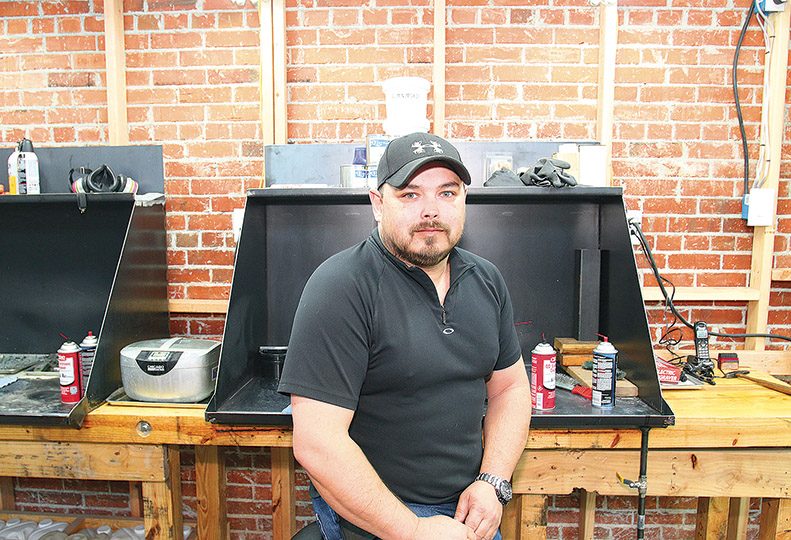
Home » Hydraulic concern sees growth in manufacturing
Hydraulic concern sees growth in manufacturing
ACM supplies, services equipment parts, valves

May 22, 2014
Advanced Concepts in Man-ufacturing LLC, a young Spokane Valley manufacturing equipment service and supply company, has grown fourfold since its first year of operation and expects that growth to continue as the economy improves, says Eric Wellington, vice president and a principal in the company.
The company’s main focus is repair and maintenance of hydraulic valves, although it’s also a distributor for California-based Woodard HRT Inc., which is one of few U.S. manufacturers of servo valves, which are common components in automated manufacturing equipment.
ACM also distributes industrial-grade TCP Wire & Cable Corp. products and fabricates custom cable systems.
In addition to service and repairs, ACM can design entire hydraulic systems, including valve, power, and control components, Wellington says.
“We can look at a customer’s application, and design, or help design, a complete closed-loop hydraulic system to accommodate what they’re trying to do,” he says.
Hydraulic systems use energy created by fluid pressure to activate mechanical motions. The valves ACM works with control hydraulic fluid flow at up to 60 gallons per minute with pressures as high as 5,000 pounds per square inch, Wellington says.
One of the ACM’s more popular valve models is a Woodard servo valve with onboard electronic controls. It’s slightly smaller than a 1-pound coffee can and sells for $4,800, he says.
Wellington, a hydraulics specialist, and Michael Syrcle launched ACM in 2011, and had no other employees at the time. A third principal in the company, Ron Washburn, came on board a year later. ACM has seven employees today.
Syrcle’s background is in injection molding, Wellington says, adding that he and Syrcle met through common customers in previous lines of work.
Washburn, a previous friend of Syrcle, has expertise in computer networking, a vital skill for integrating electronic system controls.
The company is located in the Spokane Business & Industrial Park, at 3808 N. Sullivan, where it occupies 5,600 square feet of leased space.
Behind the front office, ACM has a testing lab, repair stations, and shelves and racks for parts.
The service-and-repair area also includes a small machine shop for welding and fabricating parts.
Wellington says the company has quadrupled in size since its first year in operation, both in revenue and repair volume. The company’s revenue doubled in 2013 compared with 2012 revenue, he says.
“We’ve been filling up the space, but we’ve got some room to expand,” he says. “We’re building a state-of-the-art test bench that will be fully automated.”
ACM’s growing client list has topped 150 companies across North America, ranging from injection-mold operations to sawmills, he says.
In injection-molding equipment, valves are used for many functions, including controlling the speed and pressure in which hydraulic fluid moves pistons or rams to force heated liquid materials such as plastics or metals into molds.
In sawmills, the valves adjust saw blade positions. “A computer determines where the saw blades need to be for maximum yield, and the valves adjust the blades within a few microns of accuracy,” Wellington says. There are 24,500 microns in an inch.
“One sawmill produces 1.5 million board feet of lumber a day using our valves,” Wellington says.
He says he expects ACM’s growth to continue, especially if the economy continues to improve.
“Everybody’s picking up,” he says. “Injection molding has been steady, steel and aluminum production is going up, and lumber-mill production is way up. It’s the same with particle board and plywood manufacturers.”
Wellington says most of the company’s new business comes through word-of-mouth references and occasional outside sales.
The company advocates scheduled cleaning and calibration of hydraulic valves at regular intervals of one to three years, depending on how much the equipment is used and how dirty the environment is.
“Some plants, like sawmills, don’t like to stop and will run until the valve dies,” Wellington says. Other customers have spare valves they can rotate into production equipment to reduce downtime while sending the worn valve for maintenance and repair.
Latest News Special Report Manufacturing
Related Articles
Related Products





